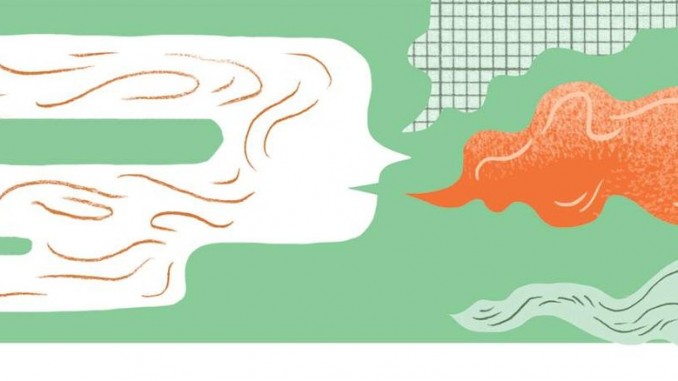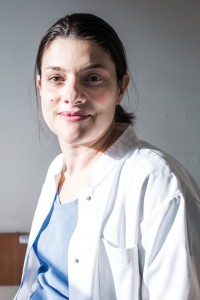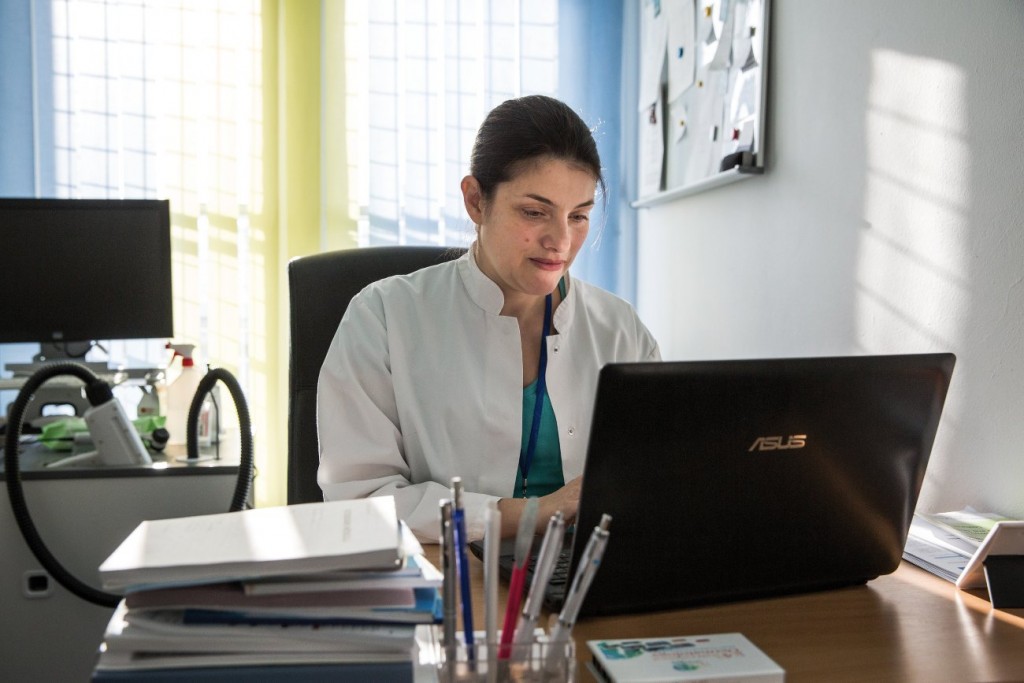
With no data from a reliable registry, and no functional national cancer plan, Romania is destined to continue suffering some of the worst cancer rates in Europe. Vlad Mixich tells the story of one dermatologist who is doing her best to break her country from endlessly re-living the same crisis
On her tenth birthday, Ana Maria Forsea told her parents that she wanted to be a scuba diver when she grew up. She was told that she would have to give up on this dream because there was nowhere in the country for her to learn. Romania was a communist country at the time – all borders were closed, people bought their daily bread ration with food coupons, hospitals had no heating, and power cuts could hit at any time, even during surgery. At Forsea’s school, like all other schools, a portrait of President Ceaușescu hung on the walls of every classroom, and children could be punished if they said what they were thinking out loud.
Then in 1989 the Berlin Wall fell, and everything changed overnight. Every single thing. The country where Forsea lived her teenage years had become chaotic but fascinating: no rules, no borders, no more parents telling their kids that they had to give up on their childhood dreams. “When I turned 18” – four years after the fall of the communist regime – “I wanted to be the best at whatever I would be doing and I wanted to be needed,” says Forsea. “I wanted my actions to matter, to have meaning to other people.” She got into the best school of medicine in the country, and this was the starting point in the journey of one of the pioneers in European dermato-oncology.
Even locals find it difficult to make any sense of the Eastern European dynamics in the ’90s, but all locals, be they Polish, Romanian or Hungarian, will summarise those days in two words: openness and transition. Forsea had her full share of both. But in 1994, the Romanian medical studies tradition was still strongly influenced by communist mentalities. The first health ministers after 1989 had also held important positions under the communist regime. Of all the sectors that needed to be reformed in Eastern Europe, the health system was and still is the hardest to change.
What made a difference was that Western European countries provided a lot of scholarships to young people on the other side of the continent. One of these gave Forsea the chance to spend her first student summer doing practical training at the Saint-Luc hospital in Brussels, Belgium. “That was the place that set the paradigm for me of what caring for patients and nursing means,” Forsea reminisces. “The way that nurses cared for the patients, the way that patients were greeted with smiles, and supported all the way to get better. It was a mind-setting experience.”
As a student, Forsea spent additional elective semesters in Bristol, UK, and Lyon, France, and says these experiences reinforced her conviction that she needed to go to learn from the best, where she could learn most. “In places where they let you learn, they support you in your learning and they encourage you to practise. A place where knowledge and information are not personal assets to be locked away safely somewhere, but things that you have to share.” This approach to gaining and sharing information was to be a defining aspect of her future life.
On graduating from the Bucharest School of Medicine, the second top student of her year, Forsea started a PhD at the Dermatology Department of the Freie Universität in Berlin, emerging two years later with a summa cum laude thesis on melanoma. The time she spent there, under the mentorship of Constantin Orfanos and Christoph Geilen, were decisive, she says, in her development as a passionate dermatologist and a committed researcher.
But when she returned to Romania to start practising as a dermatologist, she found that the realities of everyday life were brutally different. “I kept seeing advanced tumours, discovered late in the process, and people who died useless deaths. So that was when the concept of early detection in cancer became crucial. It stopped being a mere slogan and it became a necessity, a matter of practical urgency.”
It is estimated that melanoma kills more than 20,000 Europeans yearly. But there are significant differences between Western and Eastern Europe. In the West, up to 70% of newly diagnosed melanomas are less than 1 mm thick, whereas in countries like Romania or Bulgaria, that is true in less than 25% of cases. One reason is that, in many Eastern European countries, the density of doctors in city hospitals is twice as high as the national average, while large rural areas lack physicians and diagnostic facilities. Another reason, says Forsea, is the lack of awareness about skin cancer. “And there is a wide gap between what people know they should do and what they actually do in practice. Most people don’t know what they have to do in the first place, but even the few who do know still don’t do it.”
Forsea understood that to improve early detection rates in skin cancer, a lot of things had to be done right. “People need to become aware that they have a problem, then they must get out of their homes and go to the doctor, then they must be scheduled for a medical consultation, the doctor in question must understand what the issue is, must be able to make a diagnosis and then, once diagnosed, the patient must be sent where treatment is available.”
 In Eastern European countries like Romania, this flow is often broken. This is partly because the healthcare budgets in eastern countries are much smaller than on the other side of the continent, but it is also because of management shortcomngs and cultural differences, which Forsea believes need more attention. “In Romania, there are popular beliefs that may not exist in other countries. People are afraid to have a suspicious-looking mole removed because they know of an uncle who died after doing so. But this belief is actually lethal, because the removal of the mole would have saved a life,” Forsea explains.
In Eastern European countries like Romania, this flow is often broken. This is partly because the healthcare budgets in eastern countries are much smaller than on the other side of the continent, but it is also because of management shortcomngs and cultural differences, which Forsea believes need more attention. “In Romania, there are popular beliefs that may not exist in other countries. People are afraid to have a suspicious-looking mole removed because they know of an uncle who died after doing so. But this belief is actually lethal, because the removal of the mole would have saved a life,” Forsea explains.
So 10 years ago, Forsea set about establishing a foundation that aimed at challenging these misperceptions and improving skin cancer awareness. But in looking for office space she came up against another cultural barrier: stigma and taboo. “The owner of one building said ‘Oh no! No cancer in my building, it gives off negative vibes.’ These beliefs and customs vary from one country to another. So when I set up this foundation, I did it precisely because people died in vain, out of ignorance.”
Forsea used to believe that this low level of medical awareness was part of the Eastern European specificity, but what she heard from European patients’ conferences taught her differently. “It was mind-blowing for me to hear similar things everywhere, from the North to the South, from the East to the West. I kept hearing that many doctors are not sufficiently trained to detect melanoma early on and to take preventive measures. That people are not educated enough to know when they need to go to the doctor. I was already familiar with such problems in Eastern Europe, but I was less prepared to hear this in the UK for example. That cases of melanoma are diagnosed late, that the doctor did not pay enough attention to a mole that their patient was pointing out.”
Looking for data
Forsea started to ask herself some questions, “It was a researcher’s knee-jerk reaction.” She tried to identify the obstacles that block the prevention and early detection process. This, as she emphasises, meant looking for data. “No data, no research. You are left with a crystal ball.”
The search for data led to the Harvard School of Public Health in the United States, where Alan Geller, one of the leading experts on early detection and prevention of skin cancer, is based. So in 2011, that is where Forsea went. She spent a year there, researching with Geller and his team how to build an adapted strategy to improve early detection of melanoma in Eastern Europe. “He said to me, ‘OK, we’re building strategies that need to be adapted to Eastern Europe, but let’s see first where we are and where we want to go from here,’” remembers Forsea from their first encounters.
Based on her practice experience, she thought it would be easy to collect the baseline data on skin cancer. “But then I discovered that there simply was no reliable data for Eastern Europe, that I couldn’t provide any statistics matching what I knew from practice. In my career as both researcher and practitioner, that was the moment when I stumbled upon the problem of cancer registries for the first time.”
Cancer registries collect and statistically analyse data on cancer cases. The more complex the data, the more valuable the resulting statistics are. But in the absence of objective and complete data from these registries, “One simply cannot develop any strategy, any plan or intervention to reduce the cancer burden in a specific geographical area,” says Forsea, adding that the data are also needed to assess whether a strategy is useful, whether it should be a priority and, most importantly, to assess retrospectively whether or not it worked.
Yet, so far, only 29 out of the 41 European countries have quality population-based cancer registries. Some countries, such as Poland, only have local registries that cover about 10% of the population. In nine countries, located in Europe’s eastern half (Romania, Hungary and Greece included), the national cancer registries might exist legally, but do not function at a sufficient quality, so that in international statistics the data from these countries are only estimates.
“We do not know what our melanoma patients look like,” says Forsea. “We don’t know how many they are. We don’t know how late they are diagnosed. We don’t know if their risk factors are the same as in Germany, or how long they survive. We do know that in neighbouring Bulgaria, melanoma survival is 49% compared with 87% in Western Europe.” A 2014 report addressed by the European Commission to the European Parliament underlines that “at present, these registries supply the majority of epidemiological data on cancer but, most of the time, they are not managed by sufficient staff or they are not adequately planned.”
The problem sticks out immediately from a glance at current statistics. While death rates from melanoma are comparable in Western and Eastern Europe, the rate of registered new diagnoses in Central and Eastern Europe is less than half that in the western part of the continent. Such anomalies persist when looking at data from some neighbouring countries: Germany reports four times the incidence of melanoma compared to Poland, and the same difference is reported for Romania and Hungary. “It is obviously a question of diagnosing and reporting the data,” Forsea concludes.
This has serious consequences, all the more so for Eastern European countries, where the need for accurate data to maximise the impact of health policies is all the greater because financial resources are so limited.
Remembering a conference of South-Eastern European cancer registries, Forsea describes the situation as an Alice in Wonderland stance:
“Would you tell me, please, which way I ought to go from here?”
“That depends a good deal on where you want to get to,” said the Cat.
“I don’t much care where…” said Alice.
“Then it doesn’t matter which way you go,” said the Cat.
“…so long as I get somewhere,” Alice added as an explanation.
“Oh, you’re sure to do that,” said the Cat, “if you only walk long enough.”
In Romania, there are eight regional cancer registries, but only one provides data that are of sufficiently quality to be taken into consideration in European statistics. There are many reasons for this – first and foremost the high degree of legislative and political instability. In the past 25 years, Romania has had no fewer than 25 health ministers, and the ministerial orders that regulate these registries have been amended several times in recent years. Very often, these amendments are inconsistent and result in discontinuities in organisation, financing and information. For instance, it is not yet very clear who coordinates the registration at national level or how institutions that are responsible for organising these registries can be made to implement the necessary actions.
Looking for allies
Forsea emphasises that the European Union did make a considerable effort to provide member states with a set of detailed guidelines on how to design their cancer control planning and set up quality cancer registries. She also commends the vision of Vytenis Andriukaitis, the European Health Commissioner, that “investment, investment, and once again investment is the way to fight against cancer” (Cancer World Sept–Oct 2015). Yet, the EU itself also lacks political consistency. Countries such as the Netherlands, who now hold the EU presidency, frequently cite healthcare as an example of where the subsidiarity principle should apply, as they claim this is an area that member states can organise perfectly well themselves. Yet, as Forsea remarks, the disparities signalled by all European statistics and mapping clearly point to the fact that not all member states are perfectly capable of organising their healthcare.
“We must take a step forward and move from mapping to benchmarking. Starting from the indicators already put forward by the Commission, there should be a set of measurable minimum standards to allow us to concretely monitor the progress made. An external audit system would also be useful. The mapping and the analyses done so far – and they do represent a huge effort – rely mostly on the self-evaluation of member states. Objective and independent control mechanisms are crucial to improving the status quo. This type of control is not an intrusion or a coercion, it is a way to identify the problem, help allocate resources to the highest priorities, and support member states to take necessary action where they most need it.”
Making people aware of the problems and empowering them to take action on them is also crucial, says Forsea. “People are unaware of the threat that lack of data means – that they die in vain, without their case being counted. Their suffering is not at the moment quantified in data that could contribute to the prevention of similar cases in the future.”
Forsea speaks with passion, which shows from the lively sparkle in her eyes, and the determined set of her jaw. She is a product of the European medical school: Bucharest, Brussels, Bristol, Lyon and Berlin. At present, Forsea runs the largest survey conducted among European dermatologists. More than 8000 doctors have responded to questions about their practice of dermoscopy for skin cancer early detection. Her quest to bring data to the light and to improve the prevention of melanoma and the care of patients is one she will not give up easily, but she needs more allies, more support.
“Cancer registries are not an isolated issue”, she says. “They are part of a cancer control continuum that needs to be planned in the long run. Otherwise it’s always yet another Groundhog Day. We keep re-living in the same present over and over again, the same crisis, the same desperate urgency to do something right here, right now.”




